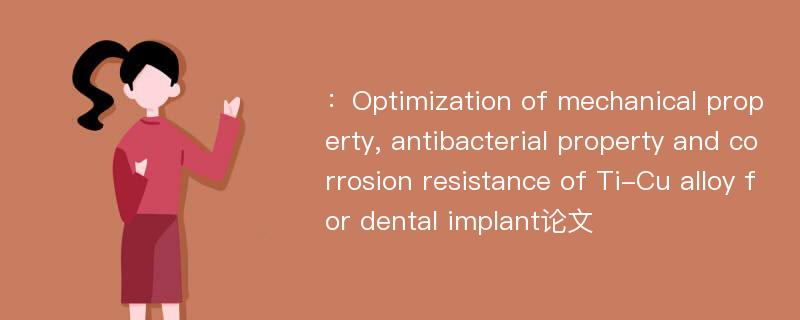
本文主要研究内容
作者(2019)在《Optimization of mechanical property, antibacterial property and corrosion resistance of Ti-Cu alloy for dental implant》一文中研究指出:Ti-Cu alloys with different Cu contents(3, 5 and 7 wt%) were fabricated and studied as novel antibacterial biomaterials for dental application. The Ti-Cu alloys were annealing treated at different temperatures(740℃, 830℃ and 910℃) in order to obtain three typical microstructures, β-Ti + Ti2Cu, β-Ti + transformed α-Ti, and transformed α-Ti. Mechanical, antibacterial and biocorrosion properties of Ti-Cu alloys with different microstructures were well analyzed by scanning electron microscopy(SEM),X-ray diffraction(XRD), transmission electron microscopy(TEM), tensile test, electrochemical test and antibacterial test. The results indicated that the Ti-Cu alloys with microstructure of β-Ti + Ti2 Cu showed the best ductility compared with other Ti-Cu alloys with microstructures of β-Ti + transformed α-Ti and complete transformed α-Ti, and meanwhile, increase of the Cu content significantly contributed to the decreased ductility due to the increasing amount of Ti2 Cu, which brought both solid solution strengthening and precipitation strengthening. Finally, the Ti-5 Cu alloy with microstructure of β-Ti + Ti2 Cu exhibited excellent ductility, antibacterial property and corrosion resistance, providing a great potential in clinical application for dental implants.
Abstract
Ti-Cu alloys with different Cu contents(3, 5 and 7 wt%) were fabricated and studied as novel antibacterial biomaterials for dental application. The Ti-Cu alloys were annealing treated at different temperatures(740℃, 830℃ and 910℃) in order to obtain three typical microstructures, β-Ti + Ti2Cu, β-Ti + transformed α-Ti, and transformed α-Ti. Mechanical, antibacterial and biocorrosion properties of Ti-Cu alloys with different microstructures were well analyzed by scanning electron microscopy(SEM),X-ray diffraction(XRD), transmission electron microscopy(TEM), tensile test, electrochemical test and antibacterial test. The results indicated that the Ti-Cu alloys with microstructure of β-Ti + Ti2 Cu showed the best ductility compared with other Ti-Cu alloys with microstructures of β-Ti + transformed α-Ti and complete transformed α-Ti, and meanwhile, increase of the Cu content significantly contributed to the decreased ductility due to the increasing amount of Ti2 Cu, which brought both solid solution strengthening and precipitation strengthening. Finally, the Ti-5 Cu alloy with microstructure of β-Ti + Ti2 Cu exhibited excellent ductility, antibacterial property and corrosion resistance, providing a great potential in clinical application for dental implants.
论文参考文献
论文详细介绍
论文作者分别是来自Journal of Materials Science & Technology的,发表于刊物Journal of Materials Science & Technology2019年10期论文,是一篇关于,Journal of Materials Science & Technology2019年10期论文的文章。本文可供学术参考使用,各位学者可以免费参考阅读下载,文章观点不代表本站观点,资料来自Journal of Materials Science & Technology2019年10期论文网站,若本站收录的文献无意侵犯了您的著作版权,请联系我们删除。
